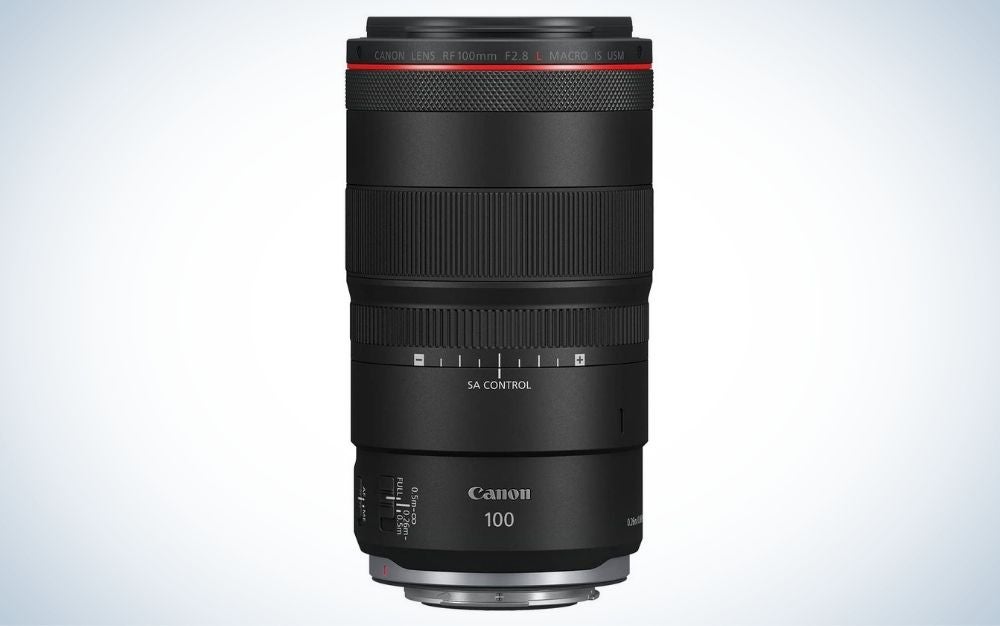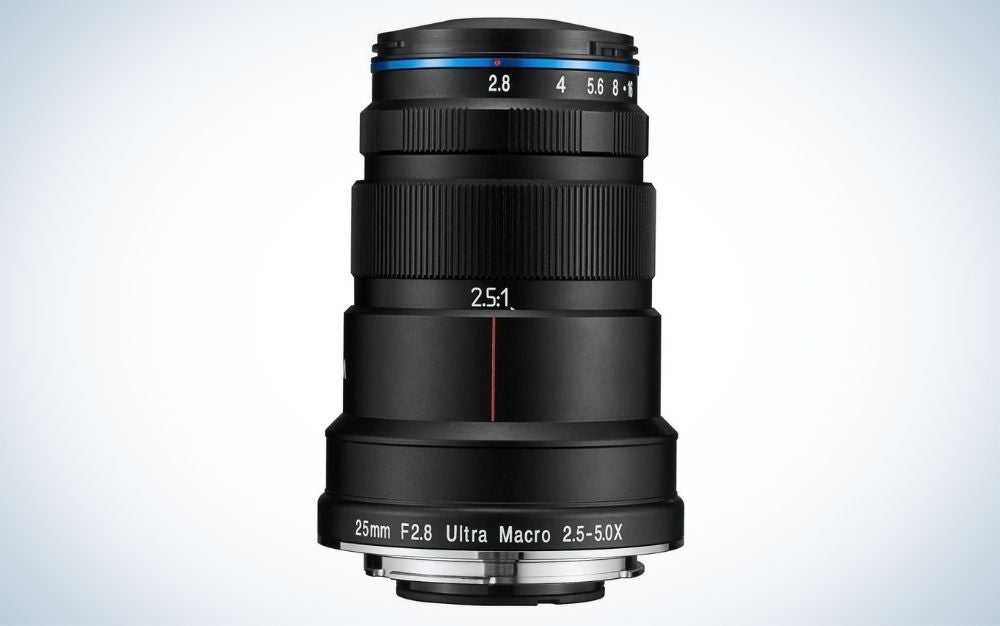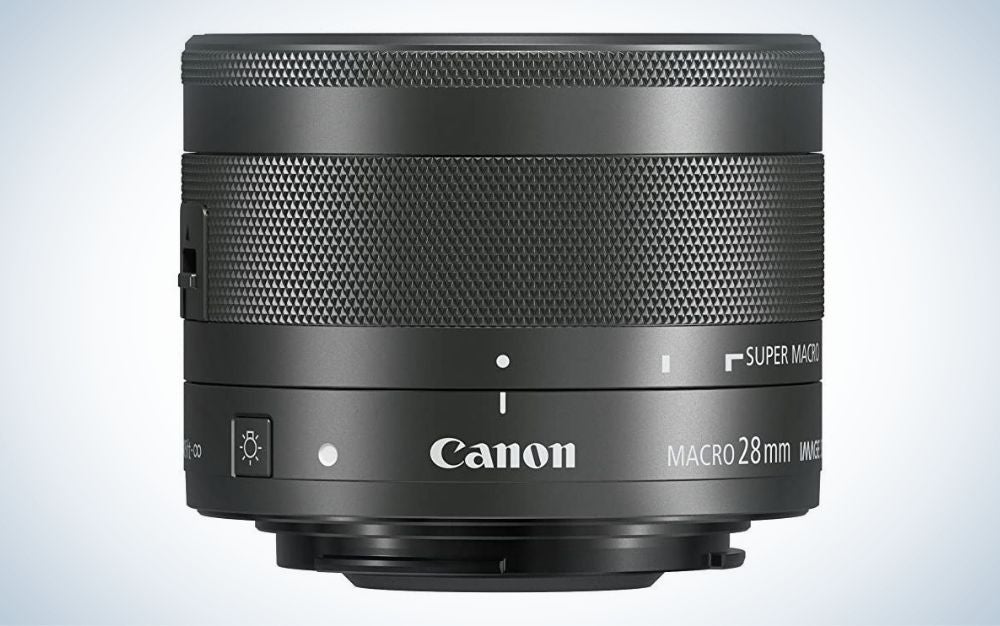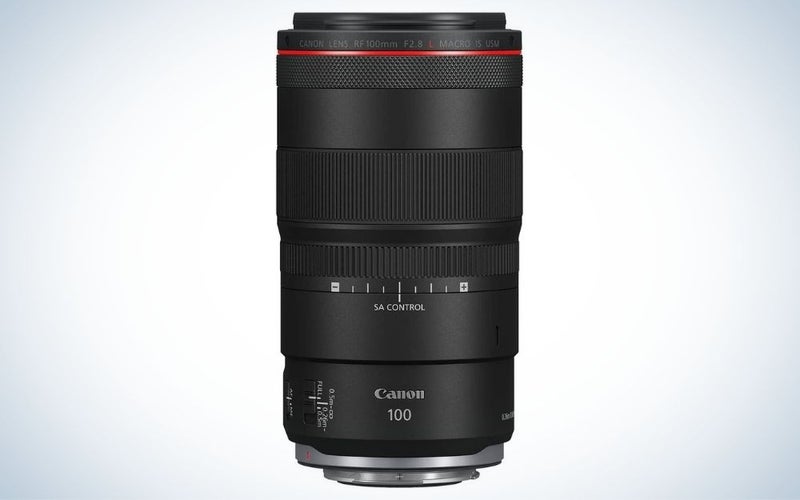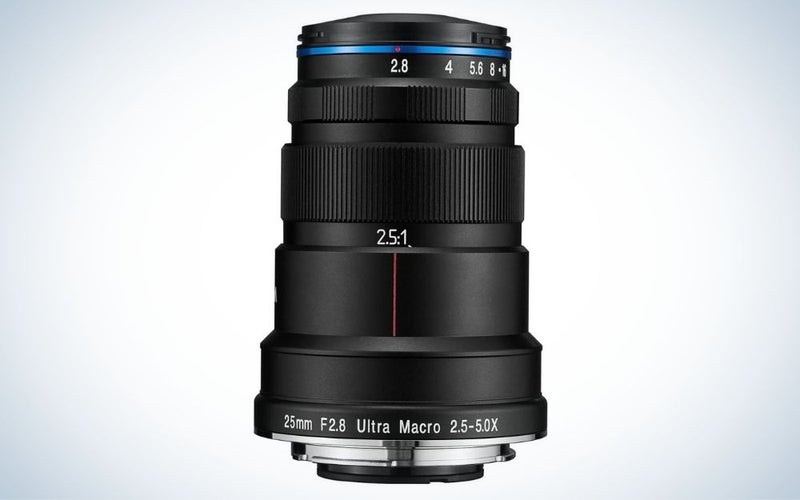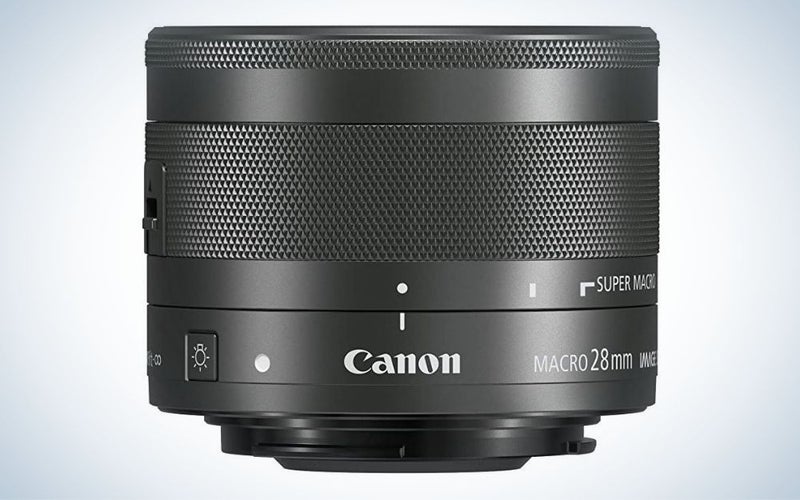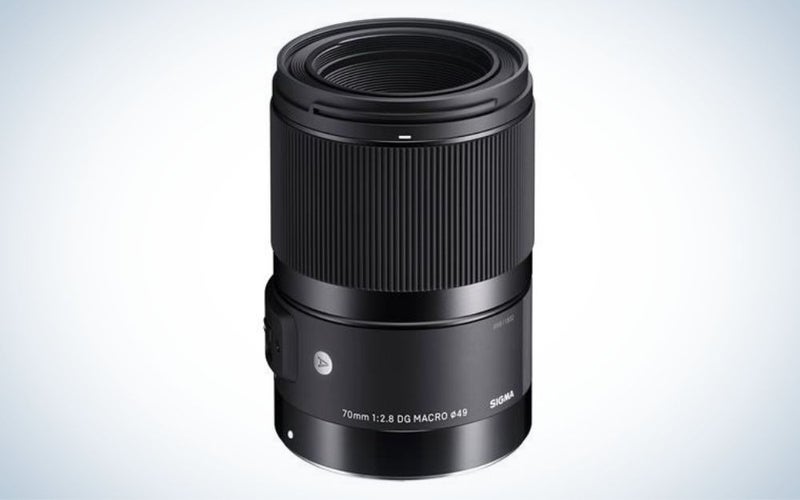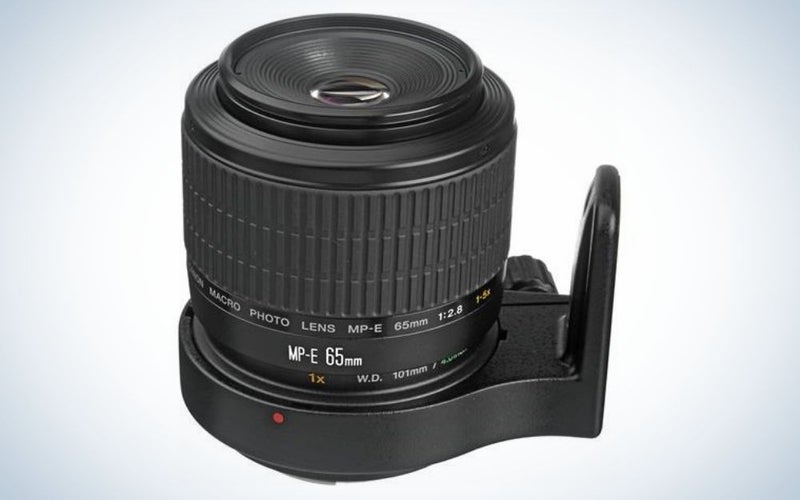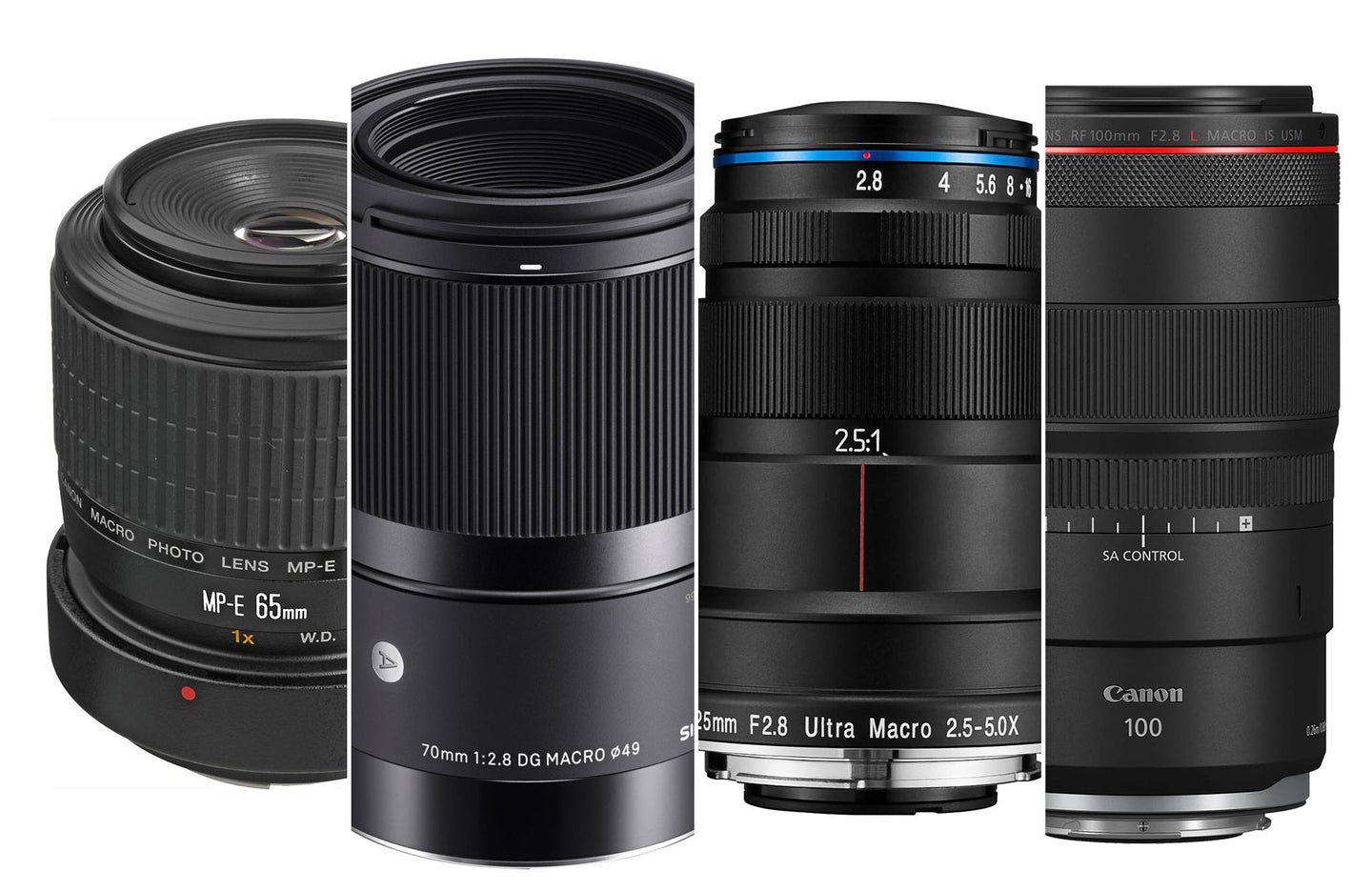
We may earn revenue from the products available on this page and participate in affiliate programs. Learn more ›
If you’re looking to start shooting close-up photography and own a Canon mirrorless camera or a DSLR, you’ll want to buy one of the best macro lenses for Canon system cameras to get the best results. To help you, we found several lenses that match the type of photography you’re interested in and that are also compatible with your Canon camera system.
But finding the precise right lens for your camera can be confusing. Like many specialized photography genres, it’s easy to get lost in the jargon (some of which is necessary) and the high number of lenses available for all the different Canon cameras currently on the market. We hope our guide helps clear up some of that confusion.
The following are the lenses we recommend for Canon DSLRs and mirrorless cameras:
- Best overall: Canon RF 100mm f/2.8L Macro IS USM Lens
- Best budget: Venus Optics Laowa 25mm f/2.8 Ultra Macro Lens
- Best for beginners: Canon EF-M 28mm f/3.5 Macro IS STM Lens
- Best third-party lens: Sigma 70mm f/2.8 DG Macro Art Lens for Canon EF
- Best for professional photographers: Canon MP-E 65mm f/2.8 1-5x Macro Photo Lens
Things to consider before buying a macro lens for Canon
Before searching for a great macro lens for your Canon camera, it’s helpful to know what a macro lens is and what “macro photography” means. Macro photography doesn’t just mean that you’ve captured an image of something up close. It actually means something quite specific: A macro photograph is anything that produces an image at a magnified ratio of 1:1 or greater, such as 1.4:1 or 2:1. That ratio is also known as magnification factor and is expressed as “1x magnification” (for a 1:1 ratio) or “2x magnification” (for a 2:1 ratio).
So, what exactly does “1:1 magnification ratio” or “1x magnification” mean?
Let me try to illustrate it with an example. If in real life, you’ve placed a tiny mustard seed that’s 1/16th of an inch long on your desk to photograph it, the projected image that your camera casts onto its image sensor must also be at least 1/16th of an inch long for it to be considered a macro photo. That’s why it’s a 1:1 ratio. The size of the mustard seed in real life is the same size as the projected image.
In some cases, a macro lens might enlarge that image: For instance, if the size of the projected image of the mustard seed is 1/8th of an inch, then the ratio is 2:1 or 2x magnification.
What’s also important to know is that some camera manufacturers make lenses that they label as macro lenses but fall short of the 1:1 magnification ratio. For instance, some lenses are marketed as macros but have just a 0.5x magnification or 1:2 ratio. The lower magnification means it’s not technically a macro lens. However, once you understand what defines a macro lens, you’ll just need to be on the lookout and read the technical specifications carefully for a lens’ magnification factor or ratio.
In addition to knowing what a macro photo is, you’ll need to figure out which macro lenses are compatible with your Canon camera body. To make things slightly more confusing, you can also buy lenses from third-party manufacturers, such as Sigma and Venus Optics. These companies make a variety of lenses compatible with Canon’s different camera systems and other systems.
Follow this guide when looking for either a Canon-branded macro lens or one made by a third-party manufacturer:
- Make sure the lens has a magnification ratio of 1:1 (1x magnification) or greater.
- If the manufacturer or retail outlet labeled the lens as a “macro” lens, disregard it unless the magnification ratio is at least 1:1.
- Pick the macro lens compatible with your camera:
- Canon’s R-series full-frame mirrorless cameras accept lenses with an RF lens mount.
- Canon’s series of full-frame DSLR cameras accept lenses with an EF lens mount.
- Canon’s APS-C mirrorless cameras accept lenses with an EF-M lens mount.
- Canon’s APS-C DSLR cameras accept lenses with either an EF or an EF-S lens mount.
Best macro lens for Canon overall: Canon RF 100mm f/2.8L Macro IS USM Lens
Canon
Why It Made The Cut: It’s the first true RF macro lens in Canon’s full-frame mirrorless lens lineup and has 1.4x magnification.
Key Features
- Mount / Format: RF-Mount Lens/Full-Frame Format
- Magnification: 1.4:1 magnification
- Minimum Focusing Distance: 10.2 inches
- Autofocus: Yes
Pros
- Unique bokeh control ring
- Has 1.4x magnification
- Includes optical image stabilization
- Dual-focus system
- Bright f/2.8 maximum aperture
Cons
- Expensive
The RF 100mm f/2.8 is Canon’s first true RF macro lens in Canon’s full-frame mirrorless lens lineup. It comes with a very impressive feature called Spherical Aberration control. Many refer to it as a bokeh control button since it allows you to control the level or amount of bokeh or blur in the foreground and background. What’s more, it has smooth and silent autofocus, which is helpful for shooting wildlife.
Another critical factor for macro photographers is that this lens has a 1.4x magnification, which means that subjects will be 40 percent larger than you could capture with Canon’s EF DSLR macro lens. Since the newer EOS RF cameras, like the R5 and R3, have high-resolution sensors, the 1.4:1 magnification ratio also lets the camera bodies capture incredibly small details in sharp focus. And because both the lens and the camera bodies have IS systems running, there’s an additional level of technology to help stabilize your images, which can be powerful, particularly in low-light situations.
Best budget: Venus Optics Laowa 25mm f/2.8 Ultra Macro Lens
LAOWA
Why It Made The Cut: The Laowa 25mm is a unique budget-priced macro lens with a high magnification range of 1:2.5 to 1:5.
Key Features
- Mount / Format: RF-Mount Lens/Full-Frame Format
- Magnification: 2.5:1 to 5:1 magnification ratios
- Minimum Focusing Distance: 6.8 inches
- Autofocus: No
Pros
- Inexpensive
- Has 2.5x to 5x magnification range
- Lightweight
Cons
- Lacks autofocus or auto exposure capabilities
- Lacks optical image stabilization
One of the things that makes this a unique macro lens for Canon full-frame mirrorless R-series cameras or a Canon EOS DSLR is that it offers you the ability to shoot images in a range of magnifications–from 2.5x up to 5x magnification. That’s very powerful. The lens is also relatively light–in fact, it’s the lightest of all the lenses we recommend, aside from the Canon EF-M 28mm f/3.5 Macro IS STM lens. It’s also smaller in diameter than almost any other lens built for an interchangeable-lens camera.
However, it does lack some features other photographers might find important. It’s a lens that does not offer the ability to focus to infinity. When positioned at 5:1 magnification, the lens has a minimum focusing distance of 6.1 inches and a working distance (or the distance from the front of the lens to the subject) of 1.6 inches. At the 2.5:1 position, the lens has a minimum focusing distance of 9.2 inches and a working distance of 1.8 inches. So, in both cases, you have to get pretty near to your subjects, which can be a challenge when photographing some wildlife subjects. It also makes it easy to cast a shadow on your subject accidentally. It does, however, have an 8-blade diaphragm design for creating a pleasing bokeh.
It’s a little less versatile than other macro lenses because you can’t use it for different types of photography, such as portraits or landscapes, but it does produce some very stunning macro photos.
Best for beginners: Canon EF-M 28mm f/3.5 Macro IS STM Lens
Canon
Why It Made The Cut: The Canon EF-M 28mm f/3.5 macro lens is a lightweight, compact, and cleverly designed prime for Canon’s M-series of mirrorless cameras.
Key Features
- Mount / Format: EF-M Mount Lens/APS-C Format
- Magnification: 1.2:1 magnification
- Minimum Focusing Distance: 3.7 inches
- Autofocus: Yes
Pros
- Includes a built-in integrated LED light
- Compact
- Lightweight
- Has a lens-based image stabilizer
- Inexpensive
Cons
- Maximum aperture is just f/3.5, not as wide as many macro lenses
One of the first things you’re apt to notice on this EF-M 28mm f/3.5 Macro IS STM lens is its unique feature—an LED light. It’s the world’s first macro lens that comes with a built-in macro light, which can illuminate hard-to-capture subjects. (Note: You’ll need to unscrew the lens hood to use the LED, which you control with buttons on the side of the lens.)
What’s also nice is that its autofocus system is functional at both ends of the spectrum: It can focus at infinity in both normal shooting and its Super Macro mode (which provides a magnification of up to 1.2x). In addition, the lens employs a Hybrid IS image stabilization system to keep things steady, which helps you capture sharp details by reducing blur due to camera shake. It’s also easy to use and has a lightweight, compact and clever design. And it’s very affordable.
Best third-party lens: Sigma 70mm f/2.8 DG Macro Art Lens
Sigma
Why It Made The Cut: Sigma’s 70mm f/2.8 with 1x magnification is an excellent choice for a macro lens from a third-party lens manufacturer.
Key Features
- Mount / Format: EF-Mount Lens/Full-Frame Format
- Magnification: 1:1 magnification
- Minimum Focusing Distance: 10.2 inches
- Autofocus: Yes
Pros
- Compact and portable
- Sharp and distortion-free
- 1x magnification
- AF/MF switch for changing from autofocus to manual focus
Cons
- Lacks optical (lens-based) image stabilization
- Lens telescopes out as its focusing
If you want to buy a versatile, easy-to-use macro prime for EOS DSLR models that isn’t made by Canon, this telephoto prime from Sigma may fit the bill. It’s compact, lightweight, and portable and can capture images and videos that are sharp and distortion-free. It also can capture macro shots with a magnification ratio of 1:1, and there’s a switch on the lens that lets you toggle between autofocus and focusing manually.
It’s not perfect since it lacks an optical image stabilizer in the lens, and the barrel of the lens also telescopes out as it’s focusing. However, it’s a very solid, well-made macro lens. And because it’s an EF lens designed for Canon DSLRs, you can use it with one of two adapters on mirrorless cameras. You can use Canon’s Mount Adapter EF-EOS M for attaching this macro lens to an EOS M-series mirrorless camera. Or use the Mount Adapter EF-EOS R-series for connecting this macro lens to an EOS R-series full-frame mirrorless camera.
Best for professionals: Canon MP-E 65mm f/2.8 1-5x Macro Photo Lens
Canon
Why It Made The Cut: The MP-E 65mm is the only Canon-branded prime lens capable of capturing images with a magnification range between 1x and 5x magnification.
Key Features
- Mount / Format: EF-Mount Lens/Full-Frame Format
- Magnification: 1:1 to 5:1
- Minimum Focusing Distance: 9.45 inches
- Autofocus: No
Pros
- Can capture macro images between a 1:1 and 5:1 magnification
- Versatile for macro photography
- Includes a magnification ring
- Sturdy construction
Cons
- Expensive
- No autofocus or image stabilization
If you’re a professional photographer who focuses on macro photography, whether you shoot commercial, nature, science, or food photography, this specialty lens might be a great addition to your photography workflow. Although it’s a short telephoto prime lens (65mm) for full-frame Canon DSLRs and a slightly longer telephoto prime lens (104mm) for Canon APS-C DSLRs, it lacks the ability to focus on infinity the way other macro lenses can. So, it’s really dedicated to just capturing macro photos.
What’s powerful about this unique lens is that it lets you render subjects within a range of magnification factors: From 1x to 5x life-size magnification. But since it’s a telephoto lens, it has a minimum focusing distance of 9.4 inches. The lens also uses floating elements to maintain quality throughout the focusing range. It is strictly a manual focus lens, but it can accept an optional macro ring light or macro twin light for improving your light setup. It also comes with a tripod collar for extra stability.
FAQs
Q: Can macro lenses be used for other types of photography?
Although macro lenses allow you to capture close-up or macro images, you can use many for various other types of photography, including portraits and landscapes as well. However, some are intended to only function as macro lenses. For example, the technical specs for such a lens often say that the lens is unable to focus on infinity distances, in which case, the lens will only work as a macro.
Q: How much do macro lenses for Canon cost?
Macro lenses for Canon costs range according to quality and features. You can find good entry-level models for around $200-$300. Professional macro lenses can get as expensive as $1,400.
Q: Are longer focal lengths the best for macro photography?
To a certain extent, longer focal lengths are the best for macro photography. In most areas of photography, focal length matters because of its impact on the field of view. In macro photography, that is not as much the case. Instead, focal length impacts macro photos because of the minimum focusing distance and working distance. Depending on your subject, standing a bit further back will be ideal. For example, if you are photographing insects or other wildlife, getting close may be either impossible or unsafe. Being further away also helps with keeping your shadow off your subject. A telephoto lens, something around 90mm and 105mm, allows you to stand back at a more comfortable distance.
Large telephoto lenses can be expensive and heavy, however. Heavy lenses can be challenging with macro photography as any movement will show up, and large lenses are more prone to causing camera shake. Thus, a tripod may be necessary, especially with long focal lengths.
Q: Should I get Manual focus or auto-focus lenses?
Choosing a manual focus or auto-focus lens mostly comes down to personal preference. If you want to use your lens for more than just macro photography, autofocus will be more versatile. Autofocus is generally faster than manual focus, so it’s also ideal for moving subjects.
That said, manual focus is frequently the focus mode of choice in macro photography. Focus precision is critical in macro photos since the amount of scene in focus within an image is already so narrow that any off focus will be very noticeable. Manual focus gives you more control and lets you really hone in on the area you want in focus. So, if you plan on using a macro lens strictly for macro photography, a manual focus lens may be the better choice.
Methodology
For our ratings of the best camera lenses for Canon, we chose current lenses that are compatible with Canon’s current lines of interchangeable-lens cameras, including its full-frame mirrorless camera system and its DSLR camera system. We not only researched and judged lenses made by Canon, but we also considered several third-party lens manufacturers. We also selected models that would appeal to the broadest spectrum of photographers and content creators.
Final thoughts on the best macro lens for Canon
Macro photography is an extraordinary genre that provides you with a powerful way to see the world differently. The Canon RF 100mm f/2.8L Macro IS USM Lens is an ideal all-around option for taking those macro images. The 10mm focal length is right in the sweet spot for minimum focus distance, as it isn’t too close or too far away. It also has a nice 1.4x magnification and built-in stabilization to help get sharp images. Lastly, the bokeh control ring gives you more control over the amount of bokeh in your pictures, which is a helpful tool.
Beyond choosing a lens, here are some important factors to consider when shooting macro photographs:
- Use a tripod to minimize even small vibrations, which can blur your photos.
- Be aware that when you shoot a macro photo, you’ll have a very shallow depth of field, making it a challenge to keep your subject in focus, particularly when you shoot outdoors.
- If you’re shooting hand-held, use in-camera image stabilization, optical (or lens-based) IS, or, best of all, a hybrid IS system that uses both IBIS and optical (or lens-based) IS.
- When shooting outdoors, it’s important to know that even a gentle wind can move your subject out of focus.
- When you use a short macro lens, be careful not to cast a shadow on your subject.
- If your lens has autofocus, experiment shooting with AF on and off and see which gives you the best results.
- Read the manual for your macro lens.
- Be patient.
The post The best macro lenses for Canon in 2023 appeared first on Popular Photography.
Articles may contain affiliate links which enable us to share in the revenue of any purchases made.
